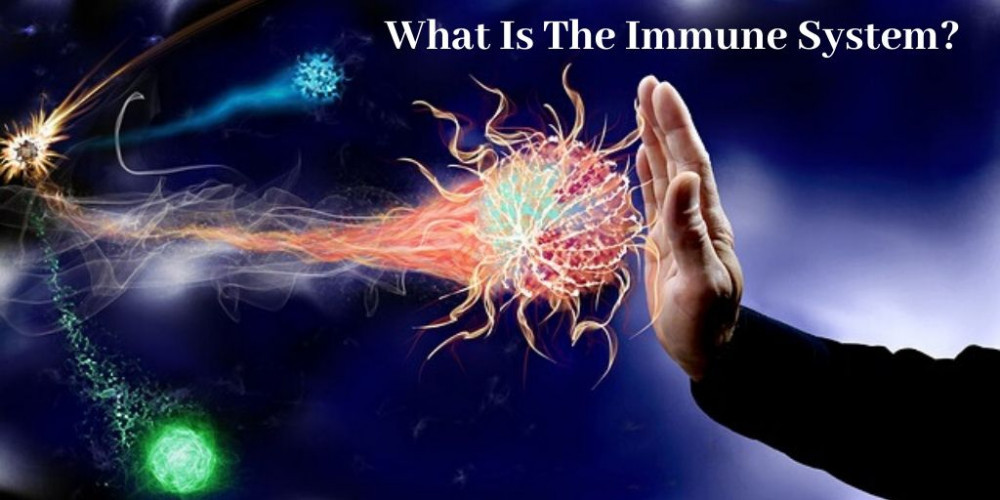What is the immune system and how does it work? The immune system is a complex system within the human body that protects against invaders, toxins, infections and cancer. It’s our primary host defense system that includes many biological processes and structures that prevent disease. There are two main immune systems, the innate immune system and the adaptive immune system. These systems work in conjunction with each other, yet perform different tasks. Let’s learn how each functions, especially in regard to cancer.

Table of Contents
What Is The Immune System and How Does It Work To Keep Us Healthy?
Humoral And Cell-Mediated Immunity
The immune system is made up of white blood cells, proteins, and the lymphatic system. The lymphatic system is crucial for fighting infection, for detoxification, and for eliminating excess fluid from the tissues. Cellular components in the bloodstream originate in the hematopoietic stem cells in the bone marrow. This includes, not only the two main types of white blood cells of the immune system, but also red blood cells (erythrocytes) and platelets. Red blood cells transport oxygen, platelets are involved in clotting. Immune cells mature either in the bone marrow or the thymus gland.
The immune system uses both humoral and cellular-defense strategies. The humoral immune response is mediated by antibodies and proteins found in body fluids, which target toxins, pathogens and malignant cells, not previously ingested by phagocytes. Antibodies are formed against antigens in the body’s “humors” – including blood and lymph. This is in opposition to cell-mediated immunity that involves T lymphocytes. Humoral immunity defends against extracellular pathogens by using antibodies.
A cell-mediated immune response does not involve antibodies, but provides defense by activating natural killer cells (NK), macrophages, cytokines, and cytotoxic T-lymphocytes that are specific to the antigen being targeted. NK and macrophages destroy pathogens within the cells, and cytotoxic T-lymphocytes induce apoptosis, or cell death, in cancer cells and cells infected with viruses or bacteria. Cytokines influence cellular function within both the innate and adaptive immune responses. Cell-mediated immunity defends against intracellular pathogens by activating T cells.
#affiliate links
The Innate Immune System
The purpose of the innate, also called the general immune system, is to provide a general defense against invaders, and to do it quickly. Although, it’s the first-line defense, the innate immune system is not a specialized response against specific pathogens. The defenses in this immune system include external barriers, such as the skin and mucous membranes, and immune substances in the blood and body fluids, such as saliva, stomach acid, mucus, and sweat. White blood cells, including macrophages, natural killer cells, neutrophils, eosinophils, basophils, and monocytes are also key defense components.
White blood cells, or leukocytes, defend against foreign invaders, antigens, and cancer cells, and are involved in the inflammatory response. Each type of white blood cell performs a specific function. Phagocytes, cells that chew or phagocytize invaders, include immune cells, such as monocytes, neutrophils, macrophages, dendritic cells, and mast cells. Some phagocytes have receptors on them for detecting bacteria, parasites, and other infection-causing pathogens. These cells also play a role in the maintenance of healthy tissue by eliminating cells that have died.
Granulocytes are white blood cells that have small granules or particles on them, which contain proteins. Neutrophils, basophils, eosinophils, and mast cells are all granulocytes. These cells are produced in the bone marrow via a process called granulopoiesis. They protect against bacterial infections, especially neutrophils, which increase when serious infection is present. Low-granulocyte count correlates with increased risk of infection.
NK, DC, Mast Cells and Macrophages
Natural killer cells: Cytotoxic lymphocytes are responsible for identifying viruses or tumor cells. NK cells induce apoptosis and are a pivotal defense against cancer cells. Natural killer cells identify changes in the surface of cells, and if found, use cytotoxins to dissolve them. They do this by releasing chemicals that breach the cell walls, causing them to lyse, or disintegrate. The role NK cells play in the innate immune system is similar to what cytotoxic T cells do in the adaptive immune response. They are not developed in the thymus like some immune cells.

Macrophages: Phagocytic, specialized immune cells that digest microbes, cellular debris, aging cells, and cancer cells. Macrophages are the “big eaters” of the immune system involved in non-specific and long-term immunity.
They digest or engulf microbes and infectious particles, presenting them to other white blood cells in the immune system, which then mount a defense against them. Monocytes in the bloodstream differentiate into macrophages once they reach a tissue or organ.
Dendritic cells: Specialized, antigen-presenting cells that present antigens to other cells within the immune system. Dendritic cells originate from tissue macrophages and monocytes, and together with them, form the mononuclear phagocyte system.
DCs are derived from bone marrow, and are found in the blood, lymphoid tissue, and skin. They’re foundational for therapeutic immunizations against lymphoma, melanoma, prostate cancer, non-small-cell lung carcinoma, colon cancer, malignant gliomas, renal cell carcinoma, and multiple myeloma.
Mast cells: Connective tissue cells found in mucous membranes and the skin. Mast cells are leukocytes that contain basophilic granules plentiful in both heparin (anti-coagulant) and histamine. These substances are released in response to inflammation and injury in the tissues. Mast cells play a role in immediate hypersensitivity reactions.
Basophils, Monocytes, Neutrophils and Eosinophils
Basophils: Granulocytes involved in allergies, inflammation, and parasitic infections. Basophils release histamine, a naturally-produced chemical associated with allergic reactions, inflammation, and injury. They account for 1% of white blood cells.
Monocytes: Macrophages that phagocytize foreign particles and cellular debris in the bloodstream, including viruses and bacteria. Monocytes fend off fungal infections, and are the largest type of white blood cell. They differentiate into dentritic cells and macrophages, and represent 5-12% of white blood cells.
Neutrophils: The most abundant of the granulocytes, neutrophils are phagocytic white blood cells that fight bacterial infections. They account for up to 50% of white blood cells. In fact, the majority of white blood cells are represented by neutrophils.
Eosinophils: Granulocytes that defend against parasites and allergic reactions. Eosinophils promote inflammation as an immune defense. They represent approximately 5% of white blood cells in the bloodstream.
The Adaptive Immune System – B and T Lymphocytes
The adaptive, or acquired immune system, is a specialized system composed of leukocytes or lymphocytes, called B and T cells. B cells are formed in the bone marrow and T cells mature in the thymus gland. Both cells defend against bacteria, viruses, and antigens.
B cells produce antibodies when foreign invaders are detected. Antibodies are proteins that attach to viruses and bacteria to form a complex. Once these antigens are tagged, T cells come to the rescue with the help of phagocytes. Antibodies are specialized for one pathogenic organism.
The adaptive immune system is called thus because of it’s ability to adapt to specific antigens, invaders, and threats. Depending on what they’re fighting, T lymphocytes can develop into different types of specialized cells, including T killer cells or cytotoxic T cells, T helper cells, regulatory T cells, and memory T cells. These lymphocytes coordinate immune responses against infections, eradicate cells infected with viruses, activate B lymphocytes, and release cytokines to regulate immune response.
Cytokines, Interleukins And Interferons
Cytokines, proteins involved in cell communication and interaction, are part of the adaptive defense. These hormone-type messenger substances, found in the tissues and blood, are both pro-inflammatory and anti-inflammatory. There are a number of cytokines that are secreted from white blood cells, including lymphokines, monokines, chemokines, and interleukins. Certain cytokines are associated with pathologic, or chronic, pain.
Interferons are a type of cytokine that prevents the replication of viruses within cells. If a cell does become infected by a virus, interferons are released. This sends the signal to other immune cells to prevent the virus from spreading. Killer T cells are activated by interferons to destroy virus-infected cells.
Tumor necrosis factor (TNF) is another immune system cytokine secreted by white blood cells in response to an antigen. TNF is involved in infection and inflammation, and is being studied as a cancer treatment due to its ability to cause necrosis, or cell death, in certain types of tumor cells. True Health Labs offers an Immunogenomic profile that tests for chronic inflammation and Th-1 and Th-2 cytokines:
Learn more here
Key Points
The immune system is a complex, fascinating web of white blood cells that protect us from cancer and infectious disease. We have both an innate and adaptive immune system that work together. When these systems aren’t working as they should, autoimmunity, cancer, and other inflammatory diseases can arise.
What do you find most intriguing about the immune system? Let me know in the comments:)
References
(1) NCBI: The components of the immune system
(2) NCBI: The innate and adaptive immune systems
(3) healthline: Understanding Neutrophils: Functions, Counts, and More
(4) Dummies by Wiley: Clinical Overview of the Immune System
(5) NCBI: Cytokines, Inflammation and Pain
(6) National Cancer Institute: NCI Dictionary of Cancer Terms
(7) DifferenceBetween.com: Difference Between Humoral and Cell Mediated Immunity
(8) WebMD: Eosinophils and Eosinophil Count Test
(9) Medical Dictionary: Mast Cells
(10) MedicineNet: Medical Definition of Natural killer cell
(11) New Medical Life Sciences: What is a Macrophage?
(12) Science Direct: Dendritic Cell
Disclaimer: This article is strictly for informational purposes only and is not intended to be medical advice.


Hey, I enjoyed a lot reading your article on the immune system. I find it very useful for everyone, including me. As we all know, our immune system is made up of white blood cells, proteins, and the lymphatic system. Our immune system uses both humoral and cellular-defense strategies. Now I know that Cytotoxic lymphocytes are responsible for identifying viruses or tumor cells. I learned a lot of new things about our immune system. I hope your guide will help everyone to learn something new, as well.
Thank you. I’m glad you learned something. The immune system, with all its components and functions, is certainly intriguing, and nothing short of an amazing defense against invaders. I appreciate you taking the time to leave a comment:)
I find it so fascinating that our immune systems have literally saved our lives dozens of times without us even knowing it. It’s always at work in the background, fighting off intruders and keeping us alive. Isn’t that crazy? Do you think that it’s a lack of exposure to certain allergens early on in life that make us allergic? Are allergies basically just failures of our immune system?
Hi Julie,
The immune system is amazing with all its various immune components. I’m sure we’ve all been exposed to bacteria or viruses at some point, but our immune systems kicked in, and prevented us from getting sick. It’s most definitely our best defense.
I think allergies are multifaceted, and both a result of compromised immunity and poor gut function, particularly food allergies. Thanks so much for reading my post:)